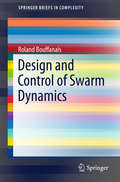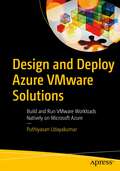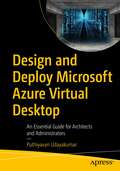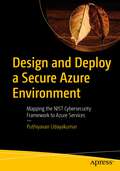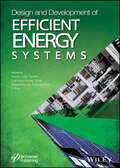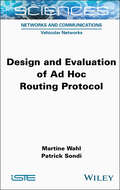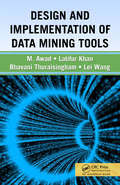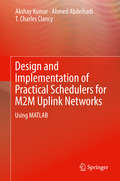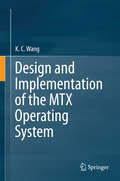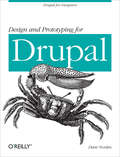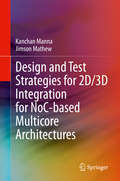- Table View
- List View
Design and Architecture for Signal and Image Processing: 15th International Workshop, DASIP 2022, Budapest, Hungary, June 20–22, 2022, Proceedings (Lecture Notes in Computer Science #13425)
by Karol Desnos Sergio PertuzThis book constitutes the thoroughly refereed conference proceedings of the First International Workshop on Design and Architecture for Signal and Image Processing, DASIP 2022, held in Budaypest, Hungary in June 2022. The 13 full included in the volume were carefully reviewed and selected from 32 submissions. They are organized in the following topical sections: leading signal, image and video processing and machine learning in custom embedded, edge and cloud computing architectures and systems.
Design and Architecture for Signal and Image Processing: 18th International Workshop, DASIP 2025, Barcelona, Spain, January 20–22, 2025, Proceedings (Lecture Notes in Computer Science #15569)
by Jordane Lorandel Ahmed KamaleldinThis book constitutes the refereed conference proceedings of the 18th International Workshop on Design and Architecture for Signal and Image Processing, DASIP 2025, held in Barcelona, Spain, during January 20-22, 2025. The 10 full papers included in this book were carefully reviewed and selected from 23 submissions.They were organized in topical sections as follows: Specialized Hardware Architecture for Efficient Processing; Efficient Processing using AI for Image, Vision and Signal Applications, and Analysis of Emerging Techniques for Signal Processing Applications.
Design and Control of Swarm Dynamics
by Roland BouffanaisThe book is about the key elements required for designing, building and controlling effective artificial swarms comprised of multiple moving physical agents. Therefore this book presents the fundamentals of each of those key elements in the particular frame of dynamic swarming, specifically exposing the profound connections between these elements and establish some general design principles for swarming behaviors. This scientific endeavor requires an inter-disciplinary approach: biomimetic inspiration from ethology and ecology, study of social information flow, analysis of temporal and adaptive signaling network of interaction, considerations of control of networked real-time systems, and lastly, elements of complex adaptive dynamical systems. This book offers a completely new perspective on the scientific understanding of dynamic collective behaviors thanks to its multi-disciplinary approach and its focus on artificial swarm of physical agents. Two of the key problems in understanding the emergence of swarm intelligent behaviors are identifying the social interaction rules a. k. a. the behavioral algorithm and uncovering how information flows between swarming agents. While most books about swarm dynamics have been focusing on the former, this book emphasizes the much-less discussed topic of distributed information flow, always with the aim of establishing general design principles.
Design and Cryptanalysis of ZUC: A Stream Cipher in Mobile Telephony (SpringerBriefs on Cyber Security Systems and Networks)
by Subhamoy Maitra Chandra Sekhar Mukherjee Dibyendu RoyThis book is a timely document of state-of-the art analytical techniques in the domain of stream cipher design and analysis with a specific cipher, named ZUC. It links new research to brief contextual literature review in the domain of complex LFSR-based stream ciphers. A snapshot of how stream ciphers are deployed in the mobile telephony architecture, one of the most well-known topics for more than five decades in the domain of computer and communication sciences, is presented in this book. The book provides an in-depth study on design and cryptanalysis of ZUC as well as relevant research results in this field with directions towards future analysis of this cipher.
Design and Deploy Azure VMware Solutions: Build and Run VMware Workloads Natively on Microsoft Azure
by Puthiyavan UdayakumarLearn the essential design and deployment skills to utilize Azure VMware Solution to seamlessly move your VMware-based workloads from your datacenter to Azure and to integrate your VMware environment with Azure. This book will teach you how to manage your existing environments with the same VMware products you already know while modernizing your applications with Azure native services. Design and Deploy Azure VMware Solutions starts by reviewing Azure VMware essentials, followed by a walkthrough of the methods of preparing and expanding to Azure VMware Solution. Here, you will learn about the layers of Microsoft AVS, including the vSphere, vSAN, NSX-T, and assess and migrate on-prem VMware workloads to Azure VMware Solution using HCX. Further, you will understand how to deploy the desktop and learn Hosting Pool using Horizon on Microsoft Azure, a modern approach to managing and securing Horizon components. VMware Tanzu for modernizing applications in Azure and disaster recovery for VMware workloads in Azure is then discussed in detail. Finally, you will learn monitoring and operations management using the VMware vRealize Suite and see a demonstration of how to plan and deploy Infrastructure as a Service (IaaS) for Azure VMware Solution via vRealize Automation. After reading the book, you will be able to migrate or extend VMware workloads from on-premises to Azure without the need to re-architect applications or retool operations.What Will You Learn Get started with Azure VMware SolutionPrepare and plan to utilize Azure VMware SolutionDesign and deploy Azure VMware SolutionManage and secure Azure VMware Solution Who Is This Book For Azure VMware administrators and Azure Cloud Architects.
Design and Deploy IoT Network & Security with Microsoft Azure: Embrace Microsoft Azure for IoT Network Enhancement and Security Uplift
by Puthiyavan Udayakumar Dr. R AnandanUnlock the potential of IoT with Microsoft Azure through this comprehensive guide, designed to elevate your understanding and implementation of cutting-edge IoT network and security solutions. Whether you are a beginner or a seasoned professional, this book offers clear, actionable insights to help you master the intricacies of IoT with Azure. This book equips you with the expertise to design and deploy secure, efficient, and scalable IoT networks using Microsoft Azure. It is your key to becoming a proficient IoT architect and security specialist. What You Will Learn Know the fundamentals of IoT networks and security, including key concepts, terminologies, and the importance of securing IoT deployments Dive into Azure Edge Services to design and deploy edge solutions that bring computation and data storage closer to the data source, enhancing speed and efficiency Explore the architecture and deployment of Azure IoT networks to gain practical knowledge on setting up scalable, reliable, and secure IoT networks tailored to your needs Study best practices and strategies for securing your IoT environment and ensuring robust protection against emerging threats Monitor and manage your IoT solutions effectively via tools and techniques for maintaining optimal performance, diagnosing issues, and ensuring seamless operation of your IoT networks Who This Book Is For IoT network and security engineers, architects, and Azure IoT developers
Design and Deploy Microsoft Azure Virtual Desktop: An Essential Guide for Architects and Administrators
by Puthiyavan UdayakumarDesign and build the new desktop service from Microsoft. This book offers a modern framework, design methodology, and best practices of design and deployment for virtual apps and desktops.Microsoft Azure Virtual Desktop (AVD) is a Desktop as a Service (DaaS) which is simple to deploy, accessible from any device, easy to manage, and secure. The book starts with AVD essentials and its critical features, followed by the planning and method of preparing for AVD. You will go through defining the requirements and assessing by setting the AVD application baseline, network requirements, and security requirements. Next, you will learn how to design and deploy the core infrastructure of Microsoft AVD to understand its Access Layer, Control Layer, Resource Layer, Hosting Layer, and User Layer. You will also learn how to design the desktop and Host Pool of AVD. And you will learn the modern way to manage and secure AVD components.After reading this book, you will have the right blend of knowledge and skills to set up and run the Azure cloud-based virtual desktop and virtual applications.What You Will LearnUnderstand the key design and deployment essentials of AVDPlan, gather requirements, and assess for AVDDesign and deploy Core Infrastructure of Microsoft AVDIntegrate with profile and personalization managementMonitor and secure Azure virtual desktopsWho Is This Book For:AVD system administrators and AVD system architects
Design and Deploy Microsoft Defender for IoT: Leveraging Cloud-based Analytics and Machine Learning Capabilities
by Puthiyavan Udayakumar Dr. R. AnandanMicrosoft Defender for IoT helps organizations identify and respond to threats aimed at IoT devices, increasingly becoming targets for cyberattacks. This book discusses planning, deploying, and managing your Defender for IoT system. The book is a comprehensive guide to IoT security, addressing the challenges and best practices for securing IoT ecosystems.The book starts with an introduction and overview of IoT in Azure. It then discusses IoT architecture and gives you an overview of Microsoft Defender. You also will learn how to plan and work with Microsoft Defender for IoT, followed by deploying OT Monitoring. You will go through air-gapped OT sensor management and enterprise IoT monitoring. You also will learn how to manage and monitor your Defender for IoT systems with network alerts and data. After reading this book, you will be able to enhance your skills with a broader understanding of IoT and Microsoft Defender for IoT-integrated best practices to design, deploy, and manage a secure enterprise IoT environment using Azure.What You Will LearnUnderstand Microsoft security services for IoTGet started with Microsoft Defender for IoTPlan and design a security operations strategy for the IoT environmentDeploy security operations for the IoT environmentManage and monitor your Defender for IoT SystemWho This Book Is ForCybersecurity architects and IoT engineers
Design and Deploy a Secure Azure Environment: Mapping the NIST Cybersecurity Framework to Azure Services
by Puthiyavan UdayakumarFollow this comprehensive guide as it provides you with a deep understanding of Azure security principles, best practices, and implementation strategies aligned with the NIST Cybersecurity Framework (CSF). The book covers various topics from Azure security to designing and deploying solutions for infrastructure, data, and applications, including identify, protect, detect, respond, and recover solutions, in line with the NIST CSF.The book will take you through an introduction and the basic requirements for cloud security aligned with the NIST CSF. And then it will teach you how to design and deploy security for infrastructure, data, and apps security in an Azure enterprise environment. The book covers the NIST CSF and various cloud services offered by Microsoft Azure, maps each service against the NIST CSF, and explains each section with design and deployment considerations from a cybersecurity viewpoint.After reading this book, you will understand NIST CSF alignment with Microsoft Azure Services. You will also have a comprehensive understanding of Azure security and be equipped with the knowledge and skills to design, deploy, and manage secure Azure environments. Whether you are a security professional, system administrator, or cloud architect, this book is a valuable resource for mastering Azure security and implementing robust security measures in the Azure environment using the NIST CSF. What You Will LearnDesign and deploy security for infrastructure, data, and applicationsDesign and deploy an identify solutionDesign and deploy a protect solutionDesign and deploy a detect solutionDesign and deploy a respond solutionDesign and deploy a recover solutionWho This Book Is ForCyber system administrators and architects working with Microsoft Azure integrated services
Design and Development Research: Methods, Strategies, and Issues
by Rita C. Richey James D. KleinAECT Design & Development Outstanding Book Award for 2008! Design and Development Research thoroughly discusses methods and strategies appropriate for conducting design and development research. Rich with examples and explanations, the book describes actual strategies that researchers have used to conduct two major types of design and development research: 1) product and tool research and 2) model research. Common challenges confronted by researchers in the field when planning and conducting a study are explored and procedural explanations are supported by a wide variety of examples taken from current literature. Samples of actual research tools are also presented. Important features in this volume include: concise checklists at the end of each chapter to give a clear summary of the steps involved in the various phases of a project; an examination of the critical types of information and data often gathered in studies, and unique procedures for collecting these data; examples of data collection instruments, as well as the use of technology in data collection; and a discussion of the process of extracting meaning from data and interpreting product and tool and model research findings. Design and Development Research is appropriate for both experienced researchers and those preparing to become researchers. It is intended for scholars interested in planning and conducting design and development research, and is intended to stimulate future thinking about methods, strategies, and issues related to the field.
Design and Development of Efficient Energy Systems (Artificial Intelligence and Soft Computing for Industrial Transformation)
by Suman Lata Tripathi Sanjeevikumar Padmanaban Dushyant Kumar Singh P. RajaThere is not a single industry which will not be transformed by machine learning and Internet of Things (IoT). IoT and machine learning have altogether changed the technological scenario by letting the user monitor and control things based on the prediction made by machine learning algorithms. There has been substantial progress in the usage of platforms, technologies and applications that are based on these technologies. These breakthrough technologies affect not just the software perspective of the industry, but they cut across areas like smart cities, smart healthcare, smart retail, smart monitoring, control, and others. Because of these “game changers,” governments, along with top companies around the world, are investing heavily in its research and development. Keeping pace with the latest trends, endless research, and new developments is paramount to innovate systems that are not only user-friendly but also speak to the growing needs and demands of society. This volume is focused on saving energy at different levels of design and automation including the concept of machine learning automation and prediction modeling. It also deals with the design and analysis for IoT-enabled systems including energy saving aspects at different level of operation. The editors and contributors also cover the fundamental concepts of IoT and machine learning, including the latest research, technological developments, and practical applications. Valuable as a learning tool for beginners in this area as well as a daily reference for engineers and scientists working in the area of IoT and machine technology, this is a must-have for any library.
Design and Development of Training Games
by Talib S. Hussain Susan L. ColemanThe multidisciplinary nature of learning-games development is key to successful projects. In this book, field leaders in serious games and professionals in entertainment games share practical guidelines and lessons from their own experiences researching and developing learning games. This volume includes: • The key elements of design and development that require particular attention from multiple disciplines to ensure success • An overview of successful models and methods, and the trade-offs made throughout the process, to guide development • Cohesive, multidisciplinary views of the issues that arise and of the techniques applied in order to produce effective learning games grounded in specific experiences, community consensus, and analysis of successful learning games that have already been released • The stories behind the games, to illustrate how final design and development decisions were reached. Aimed at professionals and academics interested in developing and researching learning games, it offers a comprehensive picture of the state of the art.
Design and Evaluation of Ad Hoc Routing Protocol (ISTE Consignment)
by Martine Wahl Patrick SondiDesign and Evaluation of Ad Hoc Routing Protocol examines ad hoc communications between vehicles in a road environment. In this context, the book questions the sustainability of communications-dependent driver assistance services in areas where no communications infrastructure is operational. Starting with an ad hoc routing protocol proposed by the authors, this book presents a methodology from its design to its evaluation. It presents the functional requirements-based design approach and offers analyses to help us understand how the protocol functions, its properties and its performance in relation to target applications. This book is primarily aimed at beginners in the fields of protocol engineering, ad hoc networks or intelligent transport systems, but also provides specialists with an original perspective on the scientific literature in these fields. In particular, it offers concrete tools to help them develop their own methods for designing and evaluating communications protocols.
Design and Implementation of 3D Graphics Systems
by Luiz Velho Jonas de Gomes Mario Costa SousaThis book covers the computational aspects of geometric modeling and rendering 3D scenes. Special emphasis is given to the architectural aspects of interactive graphics, geometric modeling, rendering techniques, the graphics pipeline, and the architecture of 3D graphics systems. The text describes basic 3D computer graphics algorithms and their implementation in the C language. The material is complemented by library routines for constructing graphics systems, which are available for download from the book's website.
Design and Implementation of Data Mining Tools
by Bhavani Thuraisingham Latifur Khan Mamoun Awad Lei WangFocusing on three applications of data mining, Design and Implementation of Data Mining Tools explains how to create and employ systems and tools for intrusion detection, Web page surfing prediction, and image classification. Mainly based on the authors' own research work, the book takes a practical approach to the subject.The first part of the boo
Design and Implementation of Fully-Integrated Inductive DC-DC Converters in Standard CMOS
by Michiel Steyaert Mike WensCMOS DC-DC Converters aims to provide a comprehensive dissertation on the matter of monolithic inductive Direct-Current to Direct-Current (DC-DC) converters. For this purpose seven chapters are defined which will allow the designer to gain specific knowledge on the design and implementation of monolithic inductive DC-DC converters, starting from the very basics.
Design and Implementation of Practical Schedulers for M2M Uplink Networks
by Ahmed Abdelhadi T. Charles Clancy Akshay KumarThis book presents the design of delay-efficient packet schedulers for heterogeneous M2M uplink traffic classified into several classes, based on packet delay requirements, payload size, arrival process, etc. Specifically, the authors use tools from queuing theory to determine the delay-optimal scheduling policy. The proposed packet schedulers are designed for a generic M2M architecture and thus equally applicable to any M2M application. Additionally, due to their low implementation complexity and excellent delay-performance, they authors show how they are also well-suited for practical M2M systems. The book pertains primarily to real-time process scheduler experts in industry/academia and graduate students whose research deals with designing Quality-of-Service-aware packet schedulers for M2M packet schedulers over existing and future cellular infrastructure. Presents queuing theoretic analysis and optimization techniques used to design proposed packet scheduling strategies;Provides utility functions to precisely model diverse delay requirements, which lends itself to formulation of utility-maximization problems for determining the delay- or utility-optimal packet scheduler;Includes detail on low implementation complexity of the proposed scheduler by using iterative and distributed optimization techniques.
Design and Implementation of the MTX Operating System
by K. C. WangThis course-tested textbook describes the design and implementation of operating systems, and applies it to the MTX operating system, a Unix-like system designed for Intel x86 based PCs. Written in an evolutional style, theoretical and practical aspects of operating systems are presented as the design and implementation of a complete operating system is demonstrated. Throughout the text, complete source code and working sample systems are used to exhibit the techniques discussed. The book contains many new materials on the design and use of parallel algorithms in SMP. Complete coverage on booting an operating system is included, as well as, extending the process model to implement threads support in the MTX kernel, an init program for system startup and a sh program for executing user commands. Intended for technically oriented operating systems courses that emphasize both theory and practice, the book is also suitable for self-study.
Design and Operation of Automated Container Storage Systems
by Nils KemmeThe storage yard is the operational and geographical centre of most seaport container terminals. Therefore, it is of particular importance for the whole terminal system and plays a major role for trade and transport flows. One of the latest trends in container-storage operations is the automated Rail-Mounted-Gantry-Crane system, which offers dense stacking, and offers low labour costs. This book investigates whether the operational performance of container terminals is influenced by the design of these storage systems and to what extent the performance is affected by the terminal's framework conditions, and discusses the strategies applied for container stacking and crane scheduling. A detailed simulation model is presented to compare the performance effects of alternative storage designs, innovative planning strategies, and other influencing factors. The results have useful implications future research, practical terminal planning and optimisation.
Design and Operation of Smart Reconfigurable Manufacturing Systems in Industry 4.0/5.0 (Springer Series in Advanced Manufacturing)
by Yoram Koren Sihan Huang Xingyu Li Xi GuThis book presents the evolution roadmap of Reconfigurable Manufacturing Systems (RMS) and their characteristics since its invention in the 1990s. It discusses the role of RMS in today&’s increasingly competitive manufacturing environment and unpredictable markets and the new challenges and opportunities in RMS design and operations in the emerging Industry 4.0/5.0 era. In addition, this book investigates the relationship between reconfigurable manufacturing and smart manufacturing and demonstrates how smart manufacturing techniques can facilitate the design and operations of RMSs. With state-of-the-art research on the development of novel methodologies based on smart manufacturing to guide the design and operations of reconfigurable machines and manufacturing systems, this book is a valuable handbook for reconfigurable manufacturing/smart manufacturing researchers and practitioners. Engineering professionals will find the practical values and managerial insights of smart RMS implementations through case studies.
Design and Optimization for 5G Wireless Communications (Wiley - IEEE)
by Haesik KimThis book offers a technical background to the design and optimization of wireless communication systems, covering optimization algorithms for wireless and 5G communication systems design. The book introduces the design and optimization systems which target capacity, latency, and connection density; including Enhanced Mobile Broadband Communication (eMBB), Ultra-Reliable and Low Latency Communication (URLL), and Massive Machine Type Communication (mMTC). The book is organized into two distinct parts: Part I, mathematical methods and optimization algorithms for wireless communications are introduced, providing the reader with the required mathematical background. In Part II, 5G communication systems are designed and optimized using the mathematical methods and optimization algorithms.
Design and Political Dissent: Spaces, Visuals, Materialities (Routledge Research in Design Studies)
by Jilly TraganouThis book examines, through an interdisciplinary lens, the relationship between political dissent and processes of designing. In the past twenty years, theorists of social movements have noted a diversity of visual and performative manifestations taking place in protest, while the fields of design, broadly defined, have been characterized by a growing interest in activism. The book’s premise stems from the recognition that material engagement and artifacts have the capacity to articulate political arguments or establish positions of disagreement. Its contributors look at a wide array of material practices generated by both professional and nonprofessional design actors around the globe, exploring case studies that vary from street protests and encampments to design pedagogy and community-empowerment projects. For students and scholars of design studies, urbanism, visual culture, politics, and social movements, this book opens up new perspectives on design and its place in contemporary politics.
Design and Prototyping for Drupal: Drupal for Designers
by Dani NordinItching to build interesting projects with Drupal, but confused by the way it handles design challenges? This concise guide helps small teams and solo website designers understand how Drupal works by demonstrating the ways it outputs content. You’ll learn how to manage Drupal’s output, design around it, and then turn your design into a theme.In the second of three volumes on Drupal design, award-winning designer Dani Nordin takes you beyond basic site planning and teaches you key strategies for working with themes, layouts, and wireframes. Discover how to use Drupal to make your vision a reality, instead of getting distracted by the system’s project and code management details.Learn strategies for sketching, wireframing, and designing effective layoutsBreak down a Drupal layout to understand its basic componentsUnderstand Drupal’s theme layer, and what to look for in a base themeWork with the 960 grid system to facilitate efficient wireframing and themingManage Drupal markup, including the code generated by the powerful Views moduleUse LessCSS to organize CSS and help you theme your site more efficiently
Design and Safety Assessment of Critical Systems
by Marco Bozzano Adolfo VillafioritaSafety-critical systems, by definition those systems whose failure can cause catastrophic results for people, the environment, and the economy, are becoming increasingly complex both in their functionality and their interactions with the environment. Unfortunately, safety assessments are still largely done manually, a time-consuming and error-prone
Design and Test Strategies for 2D/3D Integration for NoC-based Multicore Architectures
by Jimson Mathew Kanchan MannaThis book covers various aspects of optimization in design and testing of Network-on-Chip (NoC) based multicore systems. It gives a complete account of the state-of-the-art and emerging techniques for near optimal mapping and test scheduling for NoC-based multicores. The authors describe the use of the Integer Line Programming (ILP) technique for smaller benchmarks and a Particle Swarm Optimization (PSO) to get a near optimal mapping and test schedule for bigger benchmarks. The PSO-based approach is also augmented with several innovative techniques to get the best possible solution. The tradeoff between performance (communication or test time) of the system and thermal-safety is also discussed, based on designer specifications. Provides a single-source reference to design and test for circuit and system-level approaches to (NoC) based multicore systems;Gives a complete account of the state-of-the-art and emerging techniques for near optimal mapping and test scheduling in (NoC) based multicore systems;Organizes chapters systematically and hierarchically, rather than in an ad hoc manner, covering aspects of optimization in design and testing of Network-on-Chip (NoC) based multicore systems.


